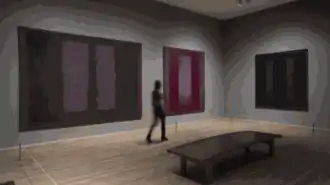Seagram murals
The Seagram murals are a series of paintings by Mark Rothko, his first to experiment with a dark palette. Originally commissioned for New York's opulent The Four Seasons Restaurant, he intended for the dark paintings to sicken the restaurant's patrons. After visiting the restaurant where his paintings were to hang, he canceled and returned his first commission. The paintings were stored and later donated some to the Tate. Rothko made 30 in the series in his lifetime.[1]

Seagram murals in their setting, at the Tate Modern
The paintings have been the subject of two documentaries and a play,[1] Red by John Logan.[2] The paintings were defaced while hanging in the Tate Modern in 2012, for which a man received a two-year prison sentence.[3][4]
References
- Cain, Abigail (November 18, 2016). "Why One Meal Made Rothko Cancel His First Major Commission". Artsy. Archived from the original on November 27, 2016. Retrieved January 19, 2021.
- Michaud, Jon (April 1, 2010). "Rothko and the Four Seasons". The New Yorker. Archived from the original on December 24, 2020. Retrieved January 19, 2021.
- Quinn, Ben (October 7, 2012). "Rothko painting defaced at Tate Modern". The Guardian. Archived from the original on November 12, 2020. Retrieved January 19, 2021.
- Brown, Mark (December 13, 2012). "Man jailed for two years for vandalising £5m Rothko at Tate Modern". The Guardian. Archived from the original on November 11, 2020. Retrieved January 19, 2021.
Further reading
- Jones, Jonathan (December 7, 2002). "How Rothko's Seagram murals found their way to London". The Guardian. Archived from the original on October 25, 2020. Retrieved January 19, 2021.
External links
This article is issued from Wikipedia. The text is licensed under Creative Commons - Attribution - Sharealike. Additional terms may apply for the media files.